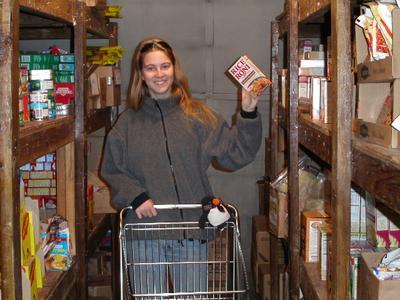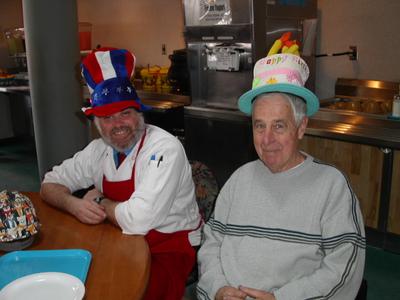30 December, 2002
An Invitation to New Zealand's Scott Base
We started our day at the Food Room where Deb assisted us in getting our food for the field. We were all there, so we could pick out the foods we liked best. We were most concerned with picking out our favorite snacks such as chocolate bars, trail mix, granola bars, and beef jerky… all things that would be easy to carry and provide quick energy.
From there, we headed to the helicopter pad for a lesson from Gifford on how to do a proper sling load. Almost all of our equipment including tents, coring rods, stoves, etc. would all need to be bundled in a large rope sling that the helicopter would then pick up and deliver to our site. We need to know how to prepare a sling load because each time we move camp sites, we must wrap up all our equipment and have it ready for the helo to pick up. It must be bundled to allow for good balance and minimal spinning or swinging as it hangs beneath the helicopter. Weight and volume are certainly important factors. The helicopters can carry sling loads of over 1400 pounds. Thank you to Gifford for allowing me to video tape this segment so that I may use the footage in presentations when I return. We often see helos delivering items through the Dry Valleys as we work. I will try to take a photo of a sling load to include in a future journal entry.
For me, the remainder of this day was devoted to trying to work on computer issues. I spent nearly the entire day working with Robbie Liben, a member of McMurdo Computer Support who helped me devise a way of possibly sending my journal entries from the field. We encountered several problems throughout the day, but he was very committed to helping me find an easy way to submit my journals via helo pilots and then to Karen Joyce at McMurdo who will post them on my website. The support from these people is truly amazing and I am grateful for their patience and assistance.
I did manage to reconnect with the other members of my team for lunch in the dining hall. There I met John, a retired colonel and his buddy who works in the cafe. They were helping me find a gentleman who will arrange for a ham radio hook up when I pass back through McMurdo in February. I tried to connect with him on Sunday for brunch, but could not find him. I heard that there were two teachers (unknown) on the USS Salem waiting to talk to me. Sorry I missed you, but I appreciate your effort! Let's hope we can connect next time. During lunch I also hooked up with Tina. Her family is from Massachusetts and her mother contacted me before I left to ask me to look her up when I arrived in McMurdo. It was nice to meet someone from home.
At 5:00 pm the US team left McMurdo to walk over to Scott Base (Kiwi Station) for an evening dinner with the New Zealand members of our team. We had a wonderful evening. The base is considerably smaller than McMurdo, hosting perhaps 50 people at one time. McMurdo can actually support as many as 2000 people at one time, but there was nowhere near that number there right now. So our home cooked Kiwi dinner was delicious and the atmosphere was peaceful and quaint.
After dinner Chris Hendy, the Kiwi Principal Investigator of our research team gave us a lecture about the glacial history of the Ross Sea area. Chris is an Associate Professor at Waikato University in New Zealand and is genuinely a leader and highly respected researcher in his field. I feel very fortunate to be working with him and learning from him every day.
We had a lovely visit to Scott Base and I thank our Kiwi hosts for a pleasant evening!

Tina from Massachusetts send her love to her family and friends back home.

Amber and Tux shopping.

Tux checks out the canned goods.

A coast guard helicopter.

Some nice guys I've met. That's Col. John on the right. They are showing off their Icestock hats.
Contact the TEA in the field at
.
If you cannot connect through your browser, copy the
TEA's e-mail address in the "To:" line of
your favorite e-mail package.
|
